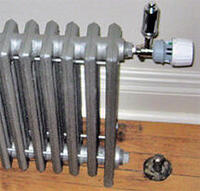HABITAT
TRV Stops Costly Overheating
Oct. 4, 2009 — As the heating season approaches, many apartment owners and co-op and condo boards are preparing for another eight months of ridiculous overheating — the familiar, sauna-like conditions New Yorkers have come to expect in many apartments in order that upper-floor apartments get enough heat.
It doesn't have to be that way. There's an inexpensive technology that, even though it's about 50 years old, few seem to know about — and it can cut overheating and fuel bills to fairly low cost. It's called a thermostatic radiator valve (TRV). If your co-op or condo board or property manager doesn't know about it, tell them.
TRVs have been popular in Europe for decades, and while they've made inroads in the U.S., they remain largely unfamiliar to most co-op / condo dwellers. In order to raise their profile, the Danish manufacturer Danfoss sponsored a small demonstration project last winter in two buildings on the Upper West Side of Manhattan. The company hired Power Concepts, a Manhattan engineering firm for which I worked at the time, to monitor the results of building-wide TRV installation at two sites — one with a one-pipe steam heating system, the other with a two-pipe system.
The team I oversaw learned a tremendous amount about what to do — and what not to do — when installing and using these valves. What we found could be useful to any building that wishes to adopt this technology.
Installation — Easy as 1-2-3-4
A typical TRV costs roughly $100, but installation labor can run up both the cost and the payback period. For this reason, we concluded that in-house installation, if at all possible, was the most cost-effective approach.
If you have a one-pipe steam system, in-house installation should be a breeze. The TRV replaces the air vent on the radiator and can be installed by any reasonably handy person in about five minutes (or 15 minutes if the TRV requires a remote temperature sensor).
Two-pipe systems present a greater challenge, and it is here where many co-op / condo boards falter: They ask a plumber for a price quote and are scared away almost immediately by the cost. Fortunately, the super in the two-pipe test building was more than willing to tackle the installation, and he and his assistant did an excellent job. Despite never having seen a TRV before, they installed nearly 200 in about three weeks.
But they did run into a few issues, most notably a need to temporarily disconnect some of the radiators at both ends, which was unusual and unanticipated. Some of the existing radiator covers required small cutouts to accommodate the TRV as well.
For another two-pipe system unrelated to the project, Danfoss developed a "drop-in" replacement cartridge suitable for Dunham-Bush orifice-type radiator valves, commonly found in many New York buildings. This reduces installation labor dramatically and virtually eliminates the need for a plumber, because no pipes have to be touched. (Unfortunately, the two-pipe building in the project did not have this option).
It's critical in one-pipe buildings without a Heat-Timer boiler control or similar device that your boiler control periodically shut off your boiler to allow steam pressure to drop essentially to zero. Hourly should do it.
Caution: Human Beings Involved
The project was intended to be as rigorous as possible, given that there were many factors outside our control — like the supers and the residents. We tried to minimize human error by sending a brief letter to each apartment describing the nature of TRVs and of the project, and by discussing with the supers in some detail what should and should not be done, especially in response to resident complaints.
From "Habitat New Products"
This being New York, many people didn't read the letter, lost it or viewed it with suspicion. And many people simply did not like the idea of TRVs, period. As a result, anytime anything went wrong with the heating system, residents blamed the TRVs, even when a causal effect was physically impossible.
Thus it was one Saturday evening while dining out of town with friends I received a semi-panicked phone call from a board member of the one-pipe building. Almost everyone in the building was complaining that they were burning up from overheating.
Now, I knew this could not be the fault of the TRVs — they can reduce overheating but not create it. I had no idea what was going on, so I reluctantly agreed to let the super turn down the Heat-Timer. When I returned to the city and heard the full story, I was incensed: The super, contrary to our specific request, had adjusted the Heat-Timer in response to a "no heat" complaint and hadn't told anyone!
Next page: Pictures! >>




